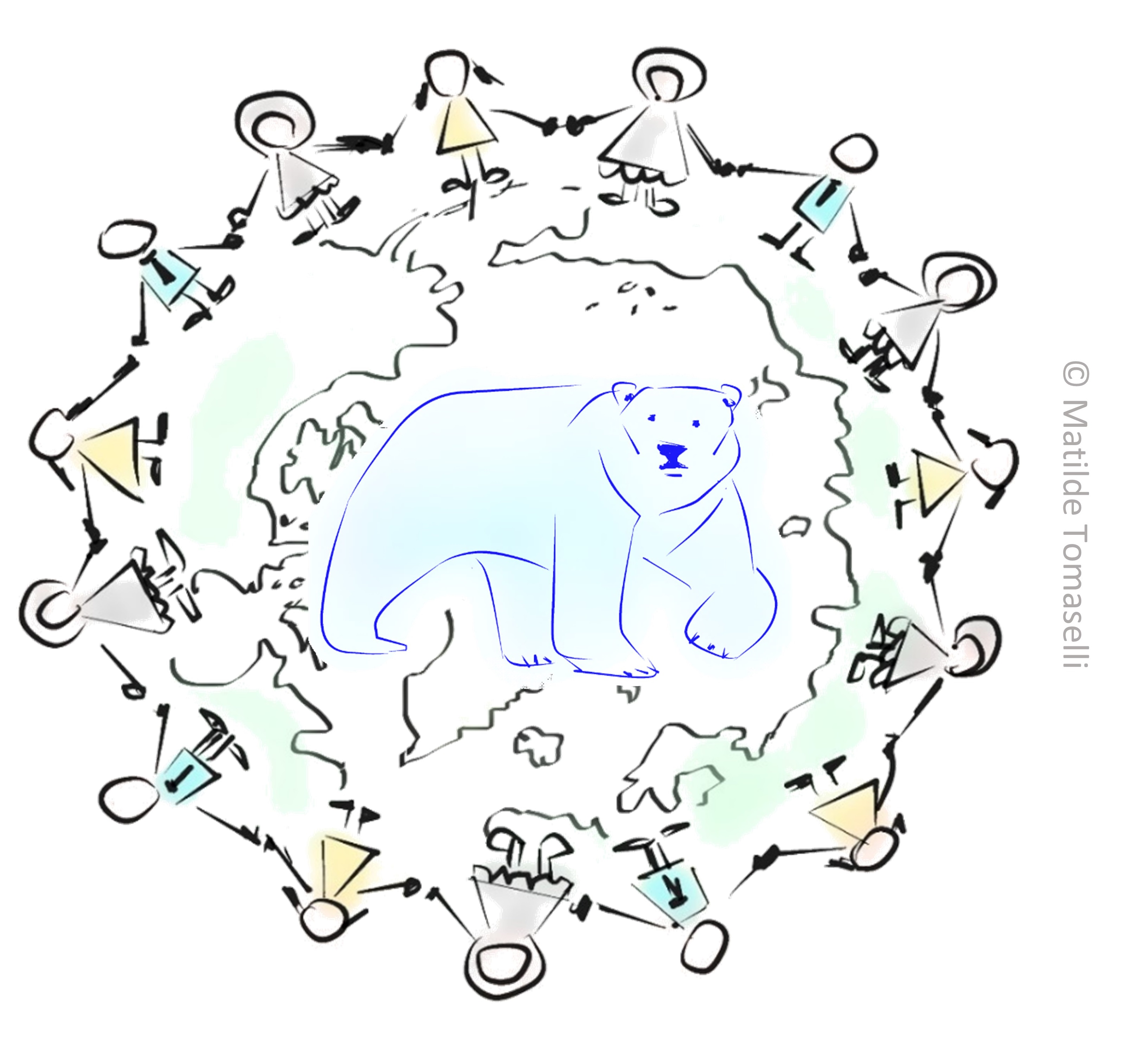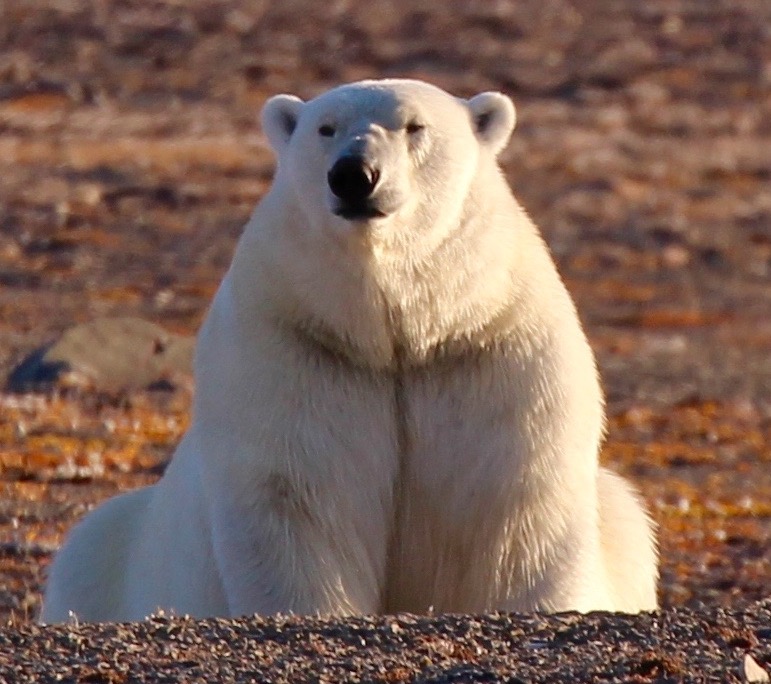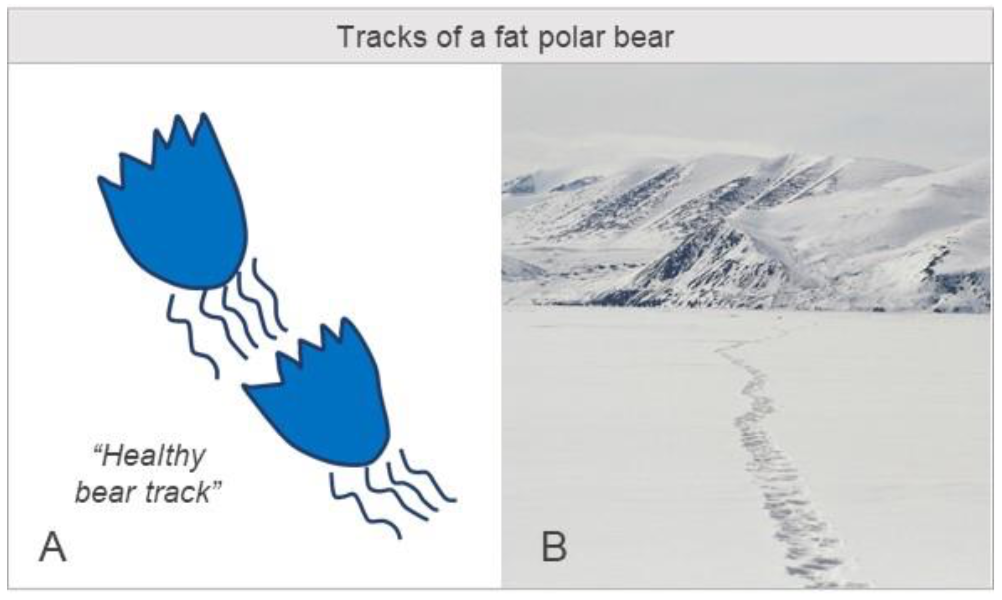Inuit polar bear experts share their knowledge in a ground-breaking new study
Polar bears are important to me. They are important for the future generations and they should be around for our young children." (Geetee Maniapik, Pangnirtung)
Around the world, polar bears are an iconic symbol of the Arctic, but for Inuit, who have always lived around them, they are inseparable from life, home and culture. Inuit, more than anyone, want to see the bears thrive well into the future.
As climate change alters conditions in the icy Arctic seas that polar bears call home, how are they faring? Are they healthy? Do they have enough to eat? Are they declining or increasing? In a new report —Nunavut Inuit Qaujimajatuqangit on the health of the Davis Strait polar bear population— Inuit polar bear experts from the Nunavut communities of Pangnirtung and Kimmirut answer these questions and more.

Matilde Tomaselli, POLAR research scientist and project co-lead, created this image to represent the many partners, including Inuit polar bear experts, who worked together on the study.
This study is the fruit of a partnership between the Hunters and Trappers Organizations from Pangnirtung and Kimmirut in the Qikiqtani region of Nunavut, the Government of Nunavut, Polar Knowledge Canada, and Environment and Climate Change Canada. It places Inuit knowledge —Inuit Qaujimajatuqangit (IQ) in Inuktitut— of polar bears front and centre, and will be an essential tool in wildlife management planning for the Davis Strait polar bear population.
The study presents a holistic view and provides a comprehensive assessment of the health of the polar bears of the Davis Strait population from the perspective of 35 Inuit polar bear experts, including men and women. It looks at the health of individual bears, the bear population and their habitat, the cultural and economic importance of polar bears, and Inuit perspectives on polar bear management and stewardship. The study also includes testimonies in which Inuit experts relate their own knowledge, views, and experiences with polar bears.

Photo: Polar Knowledge Canada
All emphasize that nanuq —polar bear in Inuktitut— is formidable, resilient and highly intelligent. But it can also be dangerous and unpredictable. Inuit have great respect for nanuq.
Polar bears are important culturally and economically and represent a source of traditional food—or country food—for Inuit. Inuit hunt polar bears for their meat and hide, which are sold or used for clothing, mattresses and blankets. Guided sport hunts, which use dog team travel rather than snowmobiles, are a source of income.
The final study report reveals that the polar bears that Inuit see around Pangnirtung and Kimmirut are generally healthy, and the local population has been growing over the past several decades. More recently, some polar bear hunters have noticed a slight decline in polar bear fatness and overall heath, and instances of hair loss (alopecia). Also, ringed seals, the main prey of polar bears, have been fewer around Kimmirut and Pangnirtung over recent decades, and the quality and quantity of sea ice has declined. Experts from both communities emphasized that the polar bear is a resilient and clever predator that adapts readily to changes in prey availability and habitat conditions. This study calls for regular documentation of Inuit knowledge and observations to understand how polar bear health will evolve over time under changing environmental conditions.
I would know by looking at the footprints whether a polar bear is healthy and fat or [if] it is skinny. You can tell by looking at its footprints...As it walks along, a healthy fat bear would drag along the fur and a bit of the claws. I would be able to tell if it was a fat, healthy bear. If it was skinny bear it would not show the same dragging marks. It would be just the footprint without the dragging marks. ... (Sandy Akavak, Kimmirut)

From the report: a drawing by Sandy Akavak, from Kimmirut, representing polar bear tracks with the dragging marks of a fat, healthy bear; and a photo of polar bear tracks on the sea ice.
Photo: David McGeachy
From this study it also emerges very clearly that public safety has become an increasing concern for Inuit. A very important aspect that requires attention and collaborative management. For example, Lazarusie Ishulutaq from Pangnirtung, relates:
Around 2000, I was here to go hunting caribou. I woke up around 4:00 in the morning and the boat was rocking, and there was a polar bear on my boat. We had just cooked seal meat that night and we woke up with a polar bear on the boat. We didn't want to shoot it because there was a big possibility that I was going to shoot the motor. I heard that when you yell as loud as you can, you can scare the polar bear. So I yelled from the top of my lungs and the bear got scared and it fell off the boat...It was a female and it had cubs...
The final study report presents a vast amount of knowledge and insight from some of the world's foremost polar bear experts. This kind of information is crucial to understanding polar bears and their ecology, and to developing effective management and stewardship practices that will maintain polar bear health, and honour the unique and longstanding relationship between Inuit and nanuq, well into the future.
Polar Knowledge Canada
For media inquiries, contact:
communications@polar-polaire.gc.ca